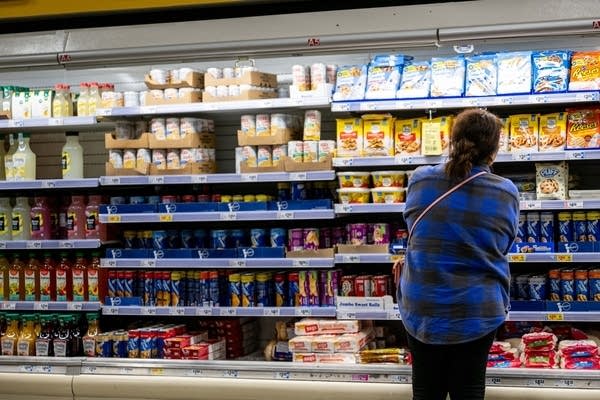What do stores do with unsold merchandise?
What is this "donate" you speak of?
Marketplace listener Blake Waller from Denmark, South Carolina asked us what retailers like Wal-Mart, Kmart and other big box stores do with items they don’t sell. We went off in pursuit of the (complicated!) answer.
When it comes to food, retailers throw away around 45 billion tons each year. That’s about 10 percent of what’s on the shelves. A lot of stores donate food that hasn’t perished. Walgreens, for example gives away about 5 million pounds of food a year to charity according to Reuben Slone, who runs supply chain for the company.
But when it comes to clothing, household goods or anything with a brand name, it gets a little more complicated.
James Merwin can attest to that. It was 2008 and he had a problem. Actually, he had 30,000 problems.
Merwin was working for a bathroom fixture company at the time. This was when the housing bubble had just burst. People stopped building houses — and they stopped buying toilets to put in them.
“You go very quickly to almost bursting at the seams with product everywhere,” Merwin says. “We had to not just fill our own warehouses; we paid a premium to store it somewhere else because we didn’t have space for it.”
This is something that happens in varying degrees to almost every retailer — from a pharmacy to a big box store. It’s called the “Bullwhip effect,” and it means you ramp up to meet what you think demand is going to be, and then demand falls off. It’s at its worst with seasonal stuff like plastic Christmas trees or clothes that go out of fashion.
Mark Barratt teaches operations and supply chain management at Marquette University. He says the first thing stores do is cut the price.
“Target has a pretty clear schedule of how long the product is sitting on the shelf before it gets discounted.”
Barratt says big box stores like Target systematically cut the price until it’s roughly 70 percent off.
“If it’s still unsold from there, they are likely to liquidate it or in some cases donate it,” Barratt says. “Or sell it to one of these discount stores like T.J. Maxx or Marshalls.”
But brands can be sensitive about their products ending up in outlets or in resale shops.
“The primary concern is the impact on the brand. Suddenly it’s, ‘Hang on a minute! We’ve spent all this time and money creating this image that we’re an upscale retailer, and now suddenly you can buy our products for 20 percent of the price if you’re just prepared to wait long enough and go to a different outlet store.”
And that same problem pops up with donating.
The trouble is, if you’re not careful, what you donate might end up on a Manhattan sidewalk sale, competing with you in front of your own store.
So many companies choose to shred, incinerate or simply throw away the stuff they can’t sell. That maybe part of the reason nearly 21 billion pounds of textiles end up in landfills each year, though a lot of that comes from us customers.
Barratt says the best way to deal with unsold merchandise is to not have much of it in the first place.
That’s why the most powerful weapon in the corporate arsenal is logistics.
Walgreens sells 18,000 different things at 8,200 different stores. That means they have to make 160 million predictions about how much merchandise to order and put out every week. Obviously, they use computers, but they also have some pretty complex data to crunch with those computers.
“What we’re trying to do is predict human behavior,” says Reuben Slone, who runs supply chain for Walgreens. “Everything that we do is based on a forecast, and that forecast is based on history.”
Take cough syrup, for example.
“We use a lot of factors,” Slone says. “Everything from weather reports to adjacent product that’s purchased. For example, if there’s a spike in aspirin and toothbrushes, that might be an indication there’s an outbreak.”
They start predicting a year ahead of time, monitoring incidences of flu around the country.
“I tell people it’s like rocket science,” Slone says.
The key is having lots of history and data. And Slone says they’ve learned some fun tricks about demand this way.
“On Christmas Day we sell more bacon than anyone else in the United States. We even have a bacon report for the Christmas holiday to monitor that.”
New products or fashion lines are what really involve some serious guesswork. But for any supply chain, one wrong move or bit of bad luck, and you can have a stack of 30,000 toilets on your doorstep. Just ask James Merwin.
“It’s as much an art as it is a science,” Merwin says. “And it’s a rodeo, or as I like to say, it’s a roller coaster.”
Whatever analogy you choose, you’ll be happy to know that Merwin did sell all of his toilets after all. He just had to discount them. No crushing or crumbling required.













